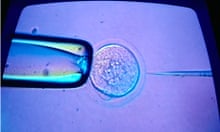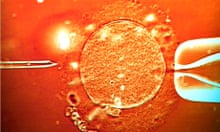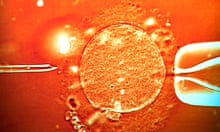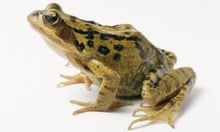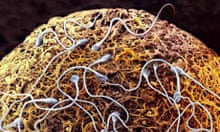The Nobel prize for physiology or medicine for 2010 has been awarded to the British scientist who pioneered in-vitro fertilisation, a procedure that has helped in the conception and birth of 4 million people around the world since the first test-tube baby, Louise Brown in 1978.
Robert Edwards, a Manchester-born physiologist, received the 10m Swedish-kronor prize in an announcement today by the Nobel Assembly at the Karolinska Institutet in Stockholm. Edwards developed the IVF technique in a research career that started in 1958 at the National Institute for Medical Research in London and continued at the world's first IVF centre, the Bourn Hall Clinic in Cambridge, founded with the English surgeon, Patrick Steptoe.
Edwards was born in 1925 in Manchester and, serving in the army in the second world war, studied biology at the University of Wales in Bangor and at Edinburgh University. At the latter, he worked on a PhD in 1955 studying the development of embryos in mice. He is currently an emeritus professor at the University of Cambridge.
Robert Edward's wife, Ruth, and his family said in a statement today that they were "thrilled and delighted" at the award of the Nobel Prize. "The success of this research has touched the lives of millions of people worldwide. His dedication and single-minded determination, despite opposition from many quarters, has led to the successful application of his pioneering research."
Worldwide around one in 10 couples are infertile and, until IVF was developed, doctors could do little to help these couples have children. Before Edwards began his work in the 1950s, scientists had shown that egg cells from rabbits could be fertilised outside the body, if they were mixed with sperm in test tubes. It took almost two decades of basic scientific study of the life cycle of human eggs before Edwards and his colleagues, in 1969, were able to successfully fertilise them outside the human body.
Speaking in 2008, Edwards recalled the moment he first created a fertilised human embryo in 1968. "I'll never get forget the day I looked down the microscope and saw something funny in the cultures. I looked down the microscope and what I saw was a human blastocyst gazing up at me. I thought: 'We've done it.'"
"The most important thing in life is having a child," he said. "Nothing is more special than a child. Steptoe and I were deeply affected by the desperation felt by couples who so wanted to have children. We had a lot of critics but we fought like hell for our patients."
Working with Steptoe, who helped pioneer laparoscopy or "keyhole surgery", Edwards removed eggs from ovaries, put them in culture and then added sperm. A decade of research followed before the birth of the world's first test-tube baby on 25 July 1978.
Lesley and John Brown had come to Edwards and Steptoe at Bourn Hall Clinic in the late 1970s, after nine years of failed attempts to have a child. Edwards and Steptoe carried out the IVF technique on one of Mrs Brown's eggs and then re-implanted it after it had become an embryo consisting of eight cells. Louise was born by caesarean section after a full-term pregnancy.
Responding to the prize announcement, Louise Brown said: "It's fantastic news, me and mum are so glad that one of the pioneers of IVF has been given the recognition he deserves. We hold Bob in great affection and are delighted to send our personal congratulations to him and his family at this time."
"During the 1950s, Edwards came to realise the potential of IVF as a treatment for this medical condition," said Christer Höög, professor of cell biology at the Karolinska Institutet in Stockholm and a member of the Nobel Assembly. "What inspired him to take on this challenge was his research on how hormones control critical ovarian functions in mice, such as oocyte maturation and ovulation. By a brilliant combination of basic and applied medical research, Edwards overcame one technical hurdle after another in his persistence to discover a method that would help to alleviate infertility. He was the first to show that human oocytes could undergo in-vitro maturation, as well as fertilisation in-vitro. He was also the first to show that in-vitro fertilised human oocytes could give rise to early-stage embryos and blastocysts."
Three decades on, IVF is an established technique to help infertile couples have children. There have been many advances on Edwards' initial research: a single sperm can now be injected directly into an egg and the extraction of eggs from ovaries has been improved so that it causes less trauma. IVF is also at the centre of a technique, called pre-implantation genetic diagnosis (PGD), that screens fertilised embryos for genetic conditions such as cystic fibrosis or Huntington's disease.
"This discovery represents a monumental medical advance that can truly be said to confer the 'greatest benefit to mankind'. Human IVF has radically changed the field of reproductive medicine. Today, 2% to 3% of all newborns in many countries are conceived with the help of IVF and many individuals that turn to an infertility clinic can be helped," Höög said. "IVF has also opened up new ways to treat many forms of male infertility. The development of IVF recognised by this year's Nobel prize in physiology or medicine has touched the life of millions of infertile people, giving them an opportunity to have children."
Steptoe, who contributed significantly to the work of developing IVF, died in 1988 and therefore cannot be jointly awarded with Edwards. The statutes of the Nobel Foundation stipulate that a prize cannot be awarded posthumously, unless the winner dies after the announcement of the prize itself.
Basil Tarlatzis of the International Federation of Fertility Societies, said: "This is a well deserved honour. IVF has opened new avenues of hope for millions of couples throughout the world. It has also had an immense impact on our understanding of medicine, leading directly to such developments as stem cell research, PGD, and many other fields. Edwards and Steptoe were real pioneers, and the award of the Nobel prize honours not just their work, but the whole field of reproductive science. After their breakthrough work, Robert went on to nurture the development of the assisted reproduction. No one deserves this award more, and we congratulate him on his award."
Martin Johnson, professor of reproductive sciences at the University of Cambridge, said he was delighted. "This is long overdue. We nominated him for the Lasker award 10 years ago and he got it immediately so we couldn't understand why the Nobel has come so late, but he is delighted – this is the cherry on the cake for him. Bob's work has always been controversial but he has never shrunk from confronting that controversy. He was a real visionary, and always ahead of his time on so many issues – not just IVF – but also on PGD in the 60s, stem cells in the 70s, and the whole process of thinking ethically."
Allan Pacey, a senior lecturer in andrology at the University of Sheffield said: "I am absolutely delighted and overwhelmed to hear this news and it is long, long overdue. Bob was a visionary and worked hard to develop IVF in a time when so many were against him. It is a tribute to his tenacity that he persevered in his research and as a consequence has changed the lives of millions across the world. My only sadness is that Bob's failing health may mean that he is less able to enjoy this award than he once was. This is a great day for him."
Martin Rees, president of the Royal Society, said: "The work of Professor Edwards exemplifies the ethos of the Royal Society, the UK's national academy of science, and of scientists everywhere - applying visionary, extraordinary research to change the lives of people all over the world. The Royal Society is delighted to congratulate him as he joins the numerous other Fellows of the Society to receive this remarkable accolade."
